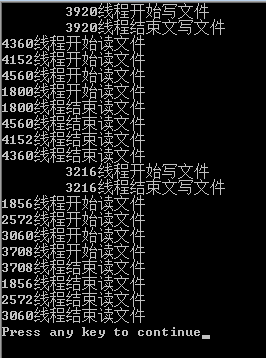问题描述
有读者和写者两组并发进程,共享一个文件,当两个或以上的读进程同时访问共享数据时不会产生副作用,但若某个写进程和其他进程(读进程或写进程)同时访问共享数据时则可能导致数据不一致的错误。因此要求:
①允许多个读者可以同时对文件执行读操作;
②只允许一个写者往文件中写信息;
③任一写者在完成写操作之前不允许其他读者或写者工作;
④写者执行写操作前,应让已有的读者和写者全部退出。
问题分析
1) 关系分析。由题目分析读者和写者是互斥的,写者和写者也是互斥的,而读者和读者不存在互斥问题。
2) 整理思路。两个进程,即读者和写者。写者是比较简单的,它和任何进程互斥,用互斥信号量的P操作、V操作即可解决。读者的问题比较复杂,它必须实现与写者互斥的同时还要实现与其他读者的同步,因此,仅仅简单的一对P操作、V操作是无法解决的。那么,在这里用到了一个计数器,用它来判断当前是否有读者读文件。当有读者的时候写者是无法写文件的,此时读者会一直占用文件,当没有读者的时候写者才可以写文件。同时这里不同读者对计数器的访问也应该是互斥的。
3) 信号量设置。首先设置信号量count为计数器,用来记录当前读者数量,初值为0; 设置mutex为互斥信号量,用于保护更新count变量时的互斥;设置互斥信号量rw用于保证读者和写者的互斥访问。
伪代码实现:
int count=0; //用于记录当前的读者数量
semaphore mutex=1; //用于保护更新count变量时的互斥
semaphore rw=1; //用于保证读者和写者互斥地访问文件
writer ()
{ //写者进程
while (true)
{
P(rw); // 互斥访问共享文件
Writing; //写入
V(rw) ; //释放共享文件
}
}
reader ()
{ // 读者进程
while(true)
{
P (mutex) ; //互斥访问count变量
if (count==0) //当第一个读进程读共享文件时
P(rw); //阻止写进程写
count++; //读者计数器加1
V (mutex) ; //释放互斥变量count
reading; //读取
P (mutex) ; //互斥访问count变量
count--; //读者计数器减1
if (count==0) //当最后一个读进程读完共享文件
V(rw) ; //允许写进程写
V (mutex) ; //释放互斥变量 count
}
}
在Windows下代码实现:读者互斥访问count用关键段,读者、写者互斥用事件完成。
#include <stdio.h>
#include <stdlib.h>
#include <time.h>
#include <process.h>
#include <windows.h>
const int writter_num = 2;
const int reader_sum = 8;
int reader_count;
HANDLE g_hEvent;
CRITICAL_SECTION g_csThreadCode;
unsigned int __stdcall writter_thread(void *param)
{
printf(" 写线程等待...
");
WaitForSingleObject(g_hEvent, INFINITE);
printf(" 写线程开始写文件...
");
Sleep(rand() % 100);
printf(" 写线程结束写文件
");
SetEvent(g_hEvent);
return 0;
}
unsigned int __stdcall reader_thread(void *param)
{
EnterCriticalSection(&g_csThreadCode);
if(reader_count == 0)
WaitForSingleObject(g_hEvent, INFINITE);
reader_count++;
LeaveCriticalSection(&g_csThreadCode);
printf("读线程%d开始读文件...
", GetCurrentThreadId());
Sleep(rand() % 100);
printf("读线程%d结束读文件
", GetCurrentThreadId());
EnterCriticalSection(&g_csThreadCode);
reader_count--;
if (reader_count == 0)
SetEvent(g_hEvent);
LeaveCriticalSection(&g_csThreadCode);
return 0;
}
int main()
{
//设置一个随机种子
srand((unsigned)time(NULL));
InitializeCriticalSection(&g_csThreadCode);
g_hEvent = CreateEvent(NULL, false, true, NULL);
//再读读者数目
reader_count = 0;
int i,j;
HANDLE handle[reader_sum + writter_num];
for (i = 0; i < reader_sum; i++)
{
handle[i] = (HANDLE)_beginthreadex(NULL, 0, reader_thread, NULL, 0, NULL);
}
for (j = i; j < reader_sum + writter_num; j++)
{
handle[j] = (HANDLE)_beginthreadex(NULL, 0, writter_thread, NULL, 0, NULL);
}
WaitForMultipleObjects(reader_sum + writter_num, handle, true, INFINITE);
DeleteCriticalSection(&g_csThreadCode);
CloseHandle(g_hEvent);
for(i = 0; i < reader_sum + 1; i++)
{
CloseHandle(handle[i]);
}
return 0;
}
执行结果:

从执行结果可以看出,在上面的算法中,读进程是优先的,也就是说,当存在读进程时,写操作将被延迟,并且只要有一个读进程活跃,随后而来的读进程都将被允许访问文件。这样的方式下,会导致写进程可能长时间等待,且存在写进程“饿死”的情况。
如果希望写进程优先,即当有读进程正在读共享文件时,有写进程请求访问,这时应禁止后续读进程的请求,等待到已在共享文件的读进程执行完毕则立即让写进程执行,只有在无写进程执行的情况下才允许读进程再次运行。为此,增加一个信号量并且在上面的程序中 writer()和reader()函数中各增加一对PV操作,就可以得到写进程优先的解决程序。
伪代码实现:
int count = 0; //用于记录当前的读者数量
semaphore mutex = 1; //用于保护更新count变量时的互斥
semaphore rw=1; //用于保证读者和写者互斥地访问文件
semaphore w=1; //用于实现“写优先”
writer()
{
while(1)
{
P(w); //在无写进程请求时进入
P(rw); //互斥访问共享文件
writing; //写入
V(rw); // 释放共享文件
V(w) ; //恢复对共享支件的访问
}
}
reader ()
{ //读者进程
while (1)
{
P (w) ; // 在无写进程请求时进入
P (mutex); // 互斥访问count变量
if (count==0) //当第一个读进程读共享文件时
P(rw); //阻止写进程写
count++; //读者计数器加1
V (mutex) ; //释放互斥变量count
V(w); //恢复对共享文件的访问
reading; //读取
P (mutex) ; //互斥访问count变量
count--; //读者计数器减1
if (count==0) //当最后一个读进程读完共享文件
V(rw); //允许写进程写
V (mutex); //释放互斥变量count
}
}
windows代码实现:
#include <stdio.h>
#include <stdlib.h>
#include <time.h>
#include <process.h>
#include <windows.h>
//定义读者和写者的数量
const int WRITER_NUM = 2;
const int READER_NUM = 8;
//读者当前的数量
int g_reader_count;
//同步变量或者内核对象
CRITICAL_SECTION g_hThreadCode;
HANDLE g_hEventrw;
HANDLE g_hEventw;
unsigned int __stdcall reader_thread(void *param)
{
WaitForSingleObject(g_hEventw, INFINITE);
EnterCriticalSection(&g_hThreadCode);
if (g_reader_count == 0)
{
WaitForSingleObject(g_hEventrw, INFINITE);
}
g_reader_count++;
LeaveCriticalSection(&g_hThreadCode);
SetEvent(g_hEventw);
printf("%d线程开始读文件
", GetCurrentThreadId());
Sleep(rand() % 100);
printf("%d线程结束读文件
", GetCurrentThreadId());
EnterCriticalSection(&g_hThreadCode);
g_reader_count--;
if (g_reader_count == 0)
{
SetEvent(g_hEventrw);
}
LeaveCriticalSection(&g_hThreadCode);
return 0;
}
unsigned int __stdcall writer_thread(void *param)
{
WaitForSingleObject(g_hEventw, INFINITE);
WaitForSingleObject(g_hEventrw, INFINITE);
printf(" %d线程开始写文件
", GetCurrentThreadId());
Sleep(rand() % 100);
printf(" %d线程结束文写文件
", GetCurrentThreadId());
SetEvent(g_hEventrw);
SetEvent(g_hEventw);
return 0;
}
int main()
{
//初始化工作
InitializeCriticalSection(&g_hThreadCode);
g_hEventrw = CreateEvent(NULL, false, true, NULL);
g_hEventw = CreateEvent(NULL, false, true, NULL);
g_reader_count = 0;
//设置随机种子
srand((unsigned int)time(NULL));
int i,j;
HANDLE handle[WRITER_NUM + READER_NUM];
for (i = 0; i < WRITER_NUM; i++)
{
handle[i] = (HANDLE)_beginthreadex(NULL, 0, writer_thread, NULL, 0, NULL);
}
for (j = i; j < WRITER_NUM + READER_NUM; j++)
{
handle[j] = (HANDLE)_beginthreadex(NULL, 0, reader_thread, NULL, 0, NULL);
}
WaitForMultipleObjects(WRITER_NUM + READER_NUM, handle, true, INFINITE);
//释放资源
DeleteCriticalSection(&g_hThreadCode);
CloseHandle(g_hEventw);
CloseHandle(g_hEventrw);
for (i = 0; i < WRITER_NUM + READER_NUM; i++)
{
CloseHandle(handle[i]);
}
return 0;
}
执行结果:

现在的写者线程就不会出现饿死的现象了。